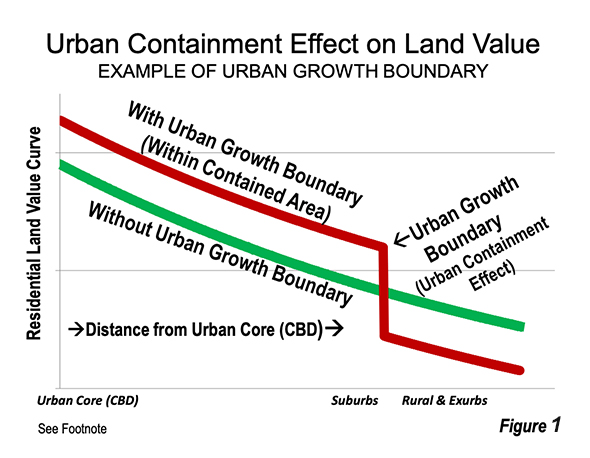
Harvard’s William Alonso showed that the value of residential land tends to increase from the rural uses on the urban fringe1 to centers of economic activity, such as central business districts.2
Urban Containment: Urban containment has become the dominant planning strategy for combating urban expansion and has been implemented in California through CEQA 3 and growth management.
According to prominent urban planners Arthur C. Nelson and Casey J. Dawkins: “… urban containment involves drawing a line around an urban area. Urban development is steered to the area inside the line and discouraged (if not prevented) outside it.”4 Further: “… urban containment programs can be distinguished from traditional approaches to land use regulation by the presence of policies that are explicitly designed to limit the development of land outside a defined urban area, while encouraging infill development and redevelopment inside the urban area.”5
Urban containment is intended to increase land costs. According to Nelson and Dawkins “ …the regional demand for urban development is shifted to the area inside the boundary. This shift should decrease the value of land outside the boundary and increase the value of land inside the boundary.”6
This article is adapted and updated from Chapter 2 (“California’s Housing Crisis”) by Wendell Cox in Saving California: Solutions to California’s Biggest Policy Problems, Stephen Greenhut, editor. The chapter is being published by newgeography.com with permission of the Pacific Research Institute, in three parts:
Part I: Housing Affordability in California: The Situation (published October 24, 2022)
Part II: Housing Affordability in California: Urban Land Markets (this piece)
Part III: Housing Affordability in California: A Way Forward
The impact of urban containment on urban land is illustrated in Figure 1 (below). The land value increases inside the urban growth boundary (UGB) are the “urban containment effect.”7 Other land value increases from land use regulation, such as “ordinary zoning” would be in addition to higher values from the urban containment effect.
Thus, the operative dynamics of urban containment are that:
- Land values rise precipitously at UGBs (or their equivalent).
- This increase is telescoped onto virtually all plots inside UGBs, raising house prices.

There was, however, a risk. Nelson and Dawkins note that “higher prices (especially for housing) could occur if planning fails to increase the supply of buildable land within the boundary” and that “…urban containment boundaries are prudent land-use policies … only when accompanied by policies that increase urban development density and intensity.”8 Housing affordability would be preserved by expanding urban containment boundaries “to accommodate projected growth over a specified future time period, typically 10 to 20 years.”9
Elusive Densification: However, sufficient densification did not occur. Perhaps the “social engineering” required to force households into smaller, often multi-family housing was politically infeasible.
Without the massive densification that would have been required to preserve housing affordability, it is not surprising that considerable political pressure has been directed toward reform of single-family zoning (an ordinary zoning measure) in markets with urban containment. As house prices have risen, so have rents (though at a slower rate10).
However, replacement of single-family zoning may not lead to materially improved housing affordability. For example, in the city of Vancouver (BC), has virtually eliminated single-family zoning11 and massively densified, increasing its population 65% from 1961 to 2016,12 without material annexation or greenfield capacity.
University of British Columbia planning Professor Patrick Condon, who has studied Vancouver extensively, has concluded “… there is a problem beyond restrictive zoning. … No amount of opening zoning or allowing for development will cause prices to go down.”13 The problem, according to Condon, is that upzoning as a densification strategy does not improve housing affordability.14
Despite the densification, Vancouver housing market had experienced massive housing affordability losses. Metro Vancouver has the highest house prices and highest rents in Canada.15 Further, Vancouver is the second least affordable market in Demographia International Housing Affordability. Affordability has worsened from a 3.9 median multiple in 197016 to 13.0 in 2020. Metro Vancouver has had stringent urban containment policy for decades.
The housing affordability (median multiple) range was far less when there was only ordinary zoning. Median multiples in major US markets did not rise above 4.0 until urban containment.17 In 2019, the 12 least affordable markets had median multiples of from 5.1 to 9.0, and all had urban containment.18
Moreover, examination of US data suggests this opposite relationship. Metros with more single-family housing and larger lot sizes (both indicators of lower density) have substantially better housing affordability (Table 3).
- San Diego, San Jose, San Francisco and Los Angeles ranked 44th through 47th in their shares of single-family housing.19
- Some of the smallest lot sizes were in San Diego (42nd), Los Angeles (47th), San Jose (48th) and San Francisco (50th).20
| Table 3 Single Family Houses & Lot Sizes Major Metropolitan Areas: By Affordability Ratings (2018) |
||
| Housing Markets (Metropolitan Areas): Number by Affordability Rating (Median Multiples Shown) |
Single Family Share of All Housing Units |
Single Family Housing Average Lot Size (Acres) |
| Affordable (3.0 & Lower) | 66.1% | 0.34 |
| Moderately Unaffordable (3.1 - 4.0) | 61.7% | 0.30 |
| Seriously Unaffordable (4.1 - 5.0) | 60.4% | 0.24 |
| Severely Unaffordable (5.0 & Higher) | 53.7% | 0.19 |
| Number of Housing Markets with Data | 53 | 50 |
| Sources: Affordability Data: American Community Survey 2018 (Census Bureau), Demographia International Housing Affordability Lot Sizes: American Housing Survey: 2011 & 2013(Census Bureau) |
||
Contravening Land Market Dynamics: Often urban containment requires new development to be adjacent to existing development. One of the world’s leading urban and housing analysts, New York University Marrron Institute Director of Urban Expansion, Shlomo Angel explains the problem with this approach.
“If only plots that were directly adjacent to existing built-up areas were allowed to develop, their owners would have monopolistic power. For the land market on the urban periphery to function properly, supply must be adequate to allow competition to determine land prices.”21
This could lead to the virtual destruction of the competitive supply of land, which Brookings Institution economist Anthony Downs stressed is required to maintain housing affordability. Legendary British planner Peter Hall,22 and colleagues at University College London expressed concern that land-use plans could “act as a speculator’s guide.” Land with planning permission or likely planning permission becomes a desirable item which will be traded at increasing prices, or hoarded.”23
Urban Containment Research: In fact, urban containment has been associated with deteriorated housing affordability.
- According to Angel: “… the explicit containment of urban expansion— by greenbelts, as in Seoul, Korea or in English cities, by urban growth boundaries, as in Portland, Oregon, or by environmental restrictions as in California—has inevitably been associated with declines in housing affordability.”
- Hall, et al suggested that by the early 1970s, the “speculative value” of land with planning permission in the UK was five to 10 times that of land without planning permission.24 They also concluded that the failure to prevent housing affordability losses was “perhaps the biggest single failure” of urban containment in the UK.
- Mariano Kulish, Anthony Richards and Christian Gillitzer of the Reserve Bank of Australia report that that land increased in value from 12 to 20 times when brought within the Melbourne UGB.25
- Arthur Grimes, former chair of the Board of the Reserve Bank of New Zealand, and Yun Liang found a land value gap of 7.9 to 13.1 times over the Auckland UGB26
- Gerald Mildner of Portland State University found that a gap in land values of 10 times across the UGB in Portland.27
- The Barker Reviews indicated that land on which housing was permitted had a value of more than 250 times that of the agricultural land outside London where housing was not permitted.28
- Benjamin Dachis of the C. D. Howe Institute has associated administration of Toronto’s urban containment (greenbelt) program with far higher house prices.29 By 2020, the median multiple had reached 250% of its 2004 (pre-urban containment) level.30
Prominent housing economists Edward Glaeser of Harvard and Joseph Gyourko of the University of Pennsylvania presented evidence in the San Francisco metropolitan area (city of San Francisco and suburbs) that land values31 were approximately $490,000, or 10 times ($440,000) the expected 20% in a well functioning market. Much of this additional cost is attributable to urban containment.
Where there is severely unaffordable housing, urban containment tends to be present.32 This includes some major markets in the United States and Canada, as well as virtually all major markets in Australia, the United Kingdom and New Zealand. All 92 severely unaffordable major markets in Demographia International Housing Affordability have urban containment.
Angel, an advocate of densification has strong reservations about urban containment:33
“You have to show me that you have enough room that you are creating for the demand for me to say it’s okay to have containment, but usually you can’t. So, what it means is that you need expansion.”
Urban containment may be the “critical mass” that explains much of the housing affordability crisis in the least affordable markets, including California.
Indeed, economist Claude Gruen observed, “…growth controls in economically powerful coastal cities is to the middle-class what the economic disaster of slum clearance was to the poor.”34
View and download endnotes (PDF opens in new tab or window)
Wendell Cox is principal of Demographia, an international public policy firm located in the St. Louis metropolitan area. He is a founding senior fellow at the Urban Reform Institute, Houston, a Senior Fellow with the Frontier Centre for Public Policy in Winnipeg and a member of the Advisory Board of the Center for Demographics and Policy at Chapman University in Orange, California. He has served as a visiting professor at the Conservatoire National des Arts et Metiers in Paris. His principal interests are economics, poverty alleviation, demographics, urban policy and transport. He is co-author of the annual Demographia International Housing Affordability Survey and author of Demographia World Urban Areas.
Mayor Tom Bradley appointed him to three terms on the Los Angeles County Transportation Commission (1977-1985) and Speaker of the House Newt Gingrich appointed him to the Amtrak Reform Council, to complete the unexpired term of New Jersey Governor Christine Todd Whitman (1999-2002). He is author of War on the Dream: How Anti-Sprawl Policy Threatens the Quality of Life and Toward More Prosperous Cities: A Framing Essay on Urban Areas, Transport, Planning and the Dimensions of Sustainability.
Photo: Embarcadero, city of San Francisco, by Bob Collowan via
Wikimedia under CC 4.0 License












